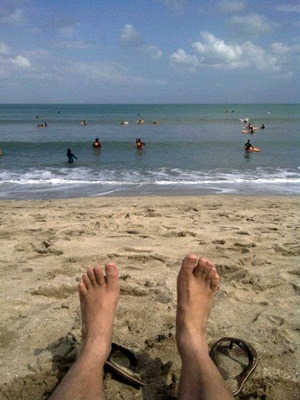 Spring-breakers headed for the beachfront be forewarned: It’s not just polluted water that can harbor illness-causing microbes; digging around in the sand can pose risks, too, especially for children.
Spring-breakers headed for the beachfront be forewarned: It’s not just polluted water that can harbor illness-causing microbes; digging around in the sand can pose risks, too, especially for children.
“Beach sand is definitely a major source of pathogen exposures,” says Northern Illinois University’s Tomoyuki Shibata, a professor of public health and an associate of the university’s Institute for the Study of the Environment, Sustainability, & Energy.
“That’s because microorganisms typically survive longer in the sand than in water, and people usually spend more time on the beachfront than in the waves,” he says. “So the sand can be a concern, particularly for children who are more susceptible and more likely to play on the beach.”
Digging in beach sand has been linked to an increased risk of gastrointestinal illness. Sources of potential pathogens in the sand could include the droppings of dogs, cats and birds on beaches or effluent from wastewater treatment plants.
Unlike beach waters, however, sand quality isn’t monitored by regulatory agencies, although the issue has gained attention in recent years. Last year, Shibata led a study that computed and proposed guidelines for acceptable levels of some bacteria, or pathogens, in marine beach sand.
The study by Shibata and co-author Helena Solo-Gabriele, a professor in the Department of Civil, Architectural and Environmental Engineering at the University of Miami, was published in the American Chemical Society journal, Environmental Science & Technology.
“Our study created benchmarks that can indicate whether certain pathogen levels are a cause for concern,” Shibata says. “We hope that our research will raise awareness among beach managers, so that they consider monitoring beach sand to make sure it’s safe for the public.”
To develop the guidelines, the scientists determined illness risks by running 1 million simulations of the number of microbes in each gram of sand, the transfer of sand from hand to mouth and the ingestion rate.
Levels of pathogens were deemed unacceptable if the simulations indicated they would cause in excess of 19 cases of illness per 1,000 beachgoers, Shibata says. This is the same threshold used by the U.S. Environmental Protection Agency for swimming in marine recreational waters.
The study did not apply to freshwater lake beaches, which have different water-quality standards, although Shibata says such guidelines could be calculated using the same simulation model.
He also says there’s no reason to consider canceling those vacation plans for spring break.
“Generally speaking, the risk of being exposed to illness-causing microbes is still low,” Shibata says. “But parents and guardians should make sure children who have been to the beach wash their hands thoroughly before eating foods and drinking beverages.
“Microorganisms are everywhere,” he adds, “but that does not mean that you will get diseases.”
His study was funded by the National Science Foundation through the Oceans and Human Health Center, at the University of Miami’s Rosenstiel School.

